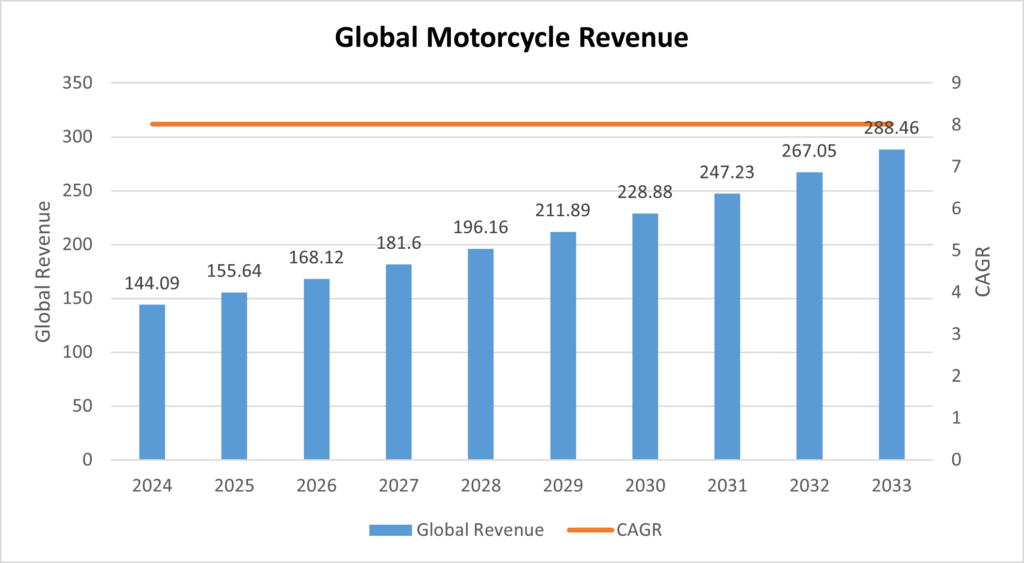
The global motorcycles market size is estimated to be valued at $144.1 billion in 2024 and is estimated to rise at a compound annual growth rate (CAGR) of 8.1% from 2024 to 2033 and to be valued at $288.46 billion in 2033, according to research by Power Systems Research (PSR).
The unit sales of Motorcycles market are expected to reach 61.62 million by 2029 according to PSR. In the United States, the trend in the motorcycle market is shifting towards electric bikes, as consumers become more environmentally conscious.

Source: Power Systems Research
Drivers of Demand. One of the key factors driving the growth of the Motorcycles market is the increasing demand for affordable and efficient transportation options.
- Motorcycles offer a cost-effective alternative to cars, especially in densely populated areas where traffic congestion is a major issue.
- Motorcycles are often preferred by younger consumers who are looking for a more adventurous and exciting mode of transportation.
- Rising urbanization and increasing disposable incomes in emerging economies have resulted in a larger middle-class population that can afford motorcycles.
- The growing middle-class population around the world is raising demand for inexpensive modes of transportation.
- Improvements in infrastructure and road networks have made motorcycles a more viable mode of transportation in many regions.
- Accessible motorcycle loans increase the purchases and expansion of the market. There are numerous banks and corporations that offer loans. These loans are simple to obtain, and the low-down payment increases the likelihood that young people and members of the middle caste will buy a motorcycle.
Trends in the Motorcycle Market. Several important trends are developing within the Motorcycle segment.
- Increasing popularity of electric motorcycles. With the growing concern for the environment and the need to reduce carbon emissions, many consumers are opting for electric motorcycles as a greener alternative to traditional gasoline-powered bikes. Electric motorcycles offer the advantages of lower maintenance costs, reduced noise pollution, and zero emissions.
- The rise of premium and luxury motorcycles. As the disposable income of consumers increases, there is a growing demand for high-end motorcycles that offer superior performance, advanced technology, and luxurious features. This trend is particularly prevalent in developed countries where consumers are willing to spend more on premium products.
- Cutting-edge technologies. The adaptability of AI for every rider, Vehicle-to-Vehicle communication and changes in ergonomic designs are changing the motorcycle market. Motorbikes have evolved into more sophisticated vehicles with a focus on safety, comfort, and luxury.
Motorcycle Market Restraint. The motorcycle market is constrained by the higher risk of accidents for riders.
Analysis. The market value of motorcycles is strongly correlated with the increasing preference of young people for motorcycles. Younger working adults and frequent travelers favor modern, cutting-edge two-wheelers. Modern technology is being incorporated into motorcycles, which has led to an increase in popularity and the growth of motorcycle events in developed economies. PSR
Michael Aistrup is Senior Analyst at Power Systems Research


